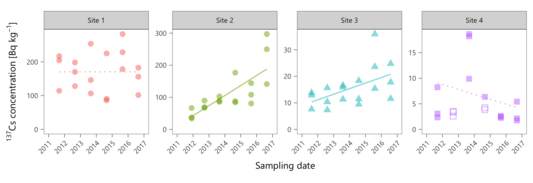241st Regular Open Seminar
Radiocesium dynamics in forests and woods after the Fukushima Dai-ichi Nuclear Power Plant accident
| 開催日時 | 2018-12-19 |
|---|
Presenter: Shinta Ohashi (Senior Researcher, Forestry and Forest Products Research Institute)
Title: Radiocesium dynamics in forests and woods after the Fukushima Dai-ichi Nuclear Power Plant accident
Place: HW525 (Research Building No. 1)
Associated Mission: Mission 1 (Environmental Diagnosis and Regulation of Circulatory Function)
ZOOM Meeting ID: 215-314-2974
Abstract
The Fukushima Dai-ichi Nuclear Power Plant accident occurred in March 2011 caused extensive radiocesium (137Cs) contamination in eastern Japan. In particular, forests are the most contaminated part on the land and will be the largest reservoir of 137Cs for decades or more because of their high land coverage rate (ca. 70 %), high 137Cs interception efficiency by branches and leaves, and high 137Cs adsorption ability of soils. Transfer of 137Cs into stem woods is also a matter of great concern. While the 137Cs transfer from foliage and bark surfaces can be a main source of the initial 137Cs contamination in woods, the amount of 137Cs transfer via root is the decisive factor for the long-term contamination. Thus, understanding the 137Cs dynamics in the forests and woods is critically important for both human activities in the forests and usage of forest products including woods in the future.
To assess the actual situation of the 137Cs contamination and understand the 137Cs dynamics in forest ecosystems, a monitoring survey have been conducted by FFPRI since 2011. It showed that the 137Cs distribution in the forests changed drastically in the first several years but afterward it was relatively steady and more than 90 % of the 137Cs in the forest has come to exist in forest floor (organic and mineral soil layers). Although the percentage of 137Cs distribution in woods is quite small, 137Cs concentration in woods of some tree species showed increasing trends at some study sites. Further monitoring surveys and detailed researches are necessary to predict the 137Cs contamination in woods accurately.
 Fig. 1 Temporal trends of 137Cs concentration in cedar woods sampled at four sites (Ohashi et al. 2017).
Fig. 1 Temporal trends of 137Cs concentration in cedar woods sampled at four sites (Ohashi et al. 2017).
Ohashi, S., Kuroda, K., Takano, T., Suzuki, Y., Kubojima, Y., Zhang, C., Yamamoto, K., 2017. Temporal trends in 137Cs concentrations in the bark, sapwood, heartwood, and whole wood of four tree species in Japanese forests from 2011 to 2016. J. Environ. Radioact. 178–179, 335–342.
PDF file (176 205 bytes) | Top
7 December, 2018
